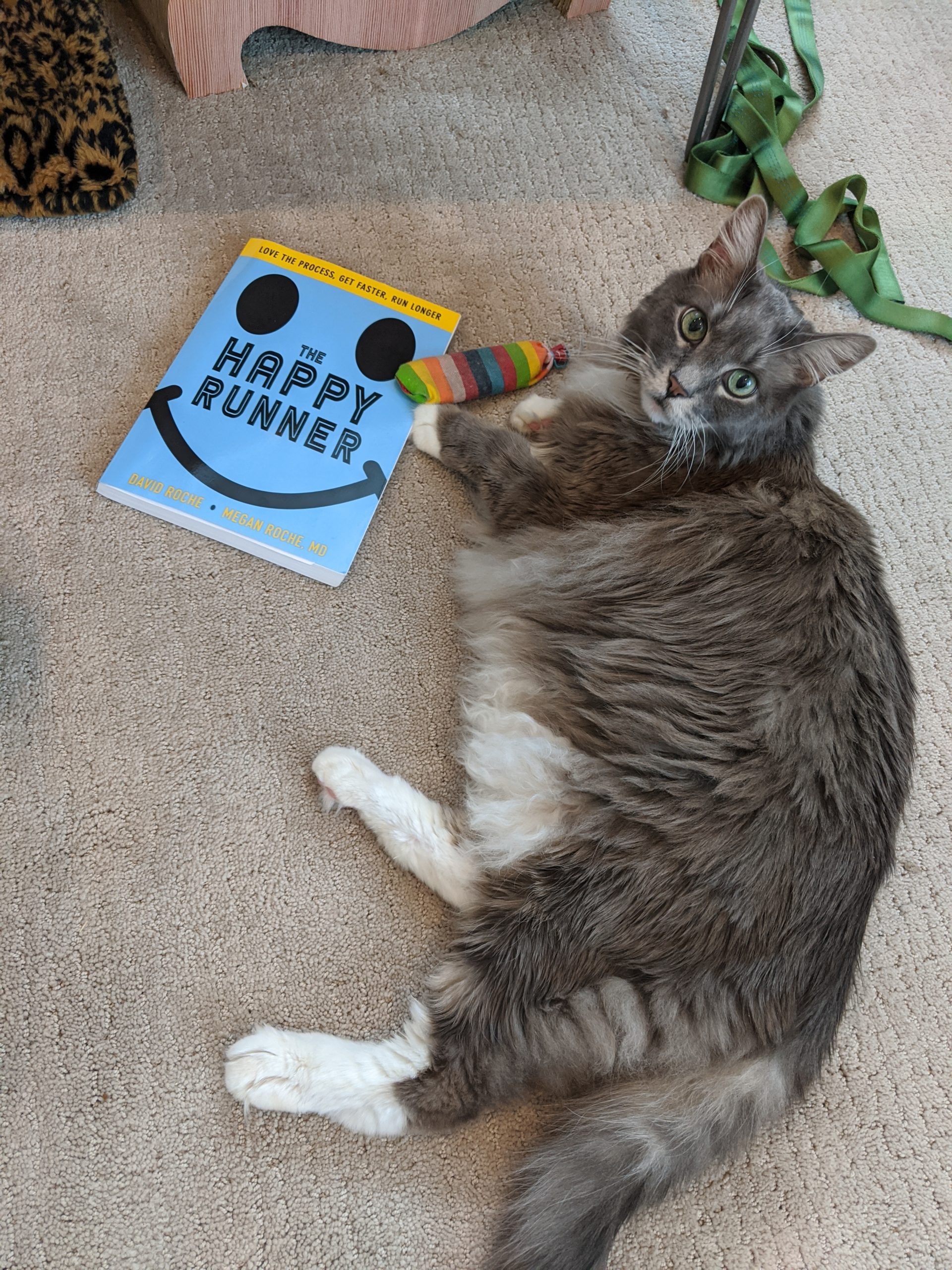The Happy Runner: Love the Process, Get Faster, Run Longer by David Roche and Megan Roche, MD (2019)
I would highly recommend this book to all runners. To say that it has fundamentally changed my perspective on training would be an understatement, but more importantly, it has given me the ability to truly enjoy events and stop worrying about whether I belong there (more on this later).
Full disclosure: I am a regular and enthusiastic reader of David Roche’s Trail Runner Magazine articles [check out the DNF Podcast “Getting to Maybe” https://trailrunnermag.com/trailrunning-podcast to hear David’s story], which provide training and attitude advice tempered with a goofy sense of humor that I find hysterical and causes Dan to ask me to read them in a different room. I also follow the book’s ghost author, Addie dog [https://www.instagram.com/addiedoesstuff/], who is a bundle of unadulterated joy. If you get nothing else from this review, just follow Addie.
I read this book on the flight to the 2019 Boston Marathon, which could not have been a better choice. The book is divided into two main sections: “The Happy Runner Rules” and “The Happy Runner Training Principles”. The central thesis that frames both sections is that “your running and your perspective on your running can support unconditional self-acceptance” (xiii). Wait, what?! Running has always given me joy and purpose, but there has also been this persistent space behind that where I compare myself to others (always unfavorably to others faster/leaner/whatever), where when I speak of myself as a runner, I feel compelled to say “I’m not fast” or “I just like to run”. For the Roches, “you are perfect and enough no matter what you look like. If your body runs, even if it’s two steps many years ago, you have a runner’s body” (42). What they also mean here is no matter what your pace is, your weekly mileage, your lack of weekly mileage, whatever variables you are sizing yourself up with, they don’t matter. You are good simply because you are. This affirming message surfaces constantly throughout the book, and I hadn’t realized how very much I needed to hear it until I heard it.
If I hadn’t read this book before landing in Boston, I would have been completely freaked out walking around town, at the race expo, at the start village, during the marathon. Road runners tend to take themselves pretty seriously (I know, I know, I’m part of this), and Boston runners are a whole other level. Everyone is pacing around in their Boston Marathon windbreakers from whatever year(s) they ran before, like some kind of low body fat anxiety gang. Everyone looks like they run 3:05 marathons before breakfast. Everyone looks like they don’t even eat breakfast. It’s INTENSE. But with the emotional tools gained from The Happy Runner, I was able to walk through this experience quietly repeating “I am enough” and “I belong here”, and because of that I could truly enjoy the tremendous privilege of running this historic event. It became fun and weird and even chill. It became awesome.
It also became clear from reading the book that other runners, even elite super fasties, feel insecure too. They doubt themselves and feel like imposters. I always assumed I was the only one who feels this way – what a revelation to realize that many – if not all – runners also experience this. It made me wonder, what could I accomplish if I stopped putting any energy into this comparison insecurity? It was consuming an inordinate amount of my energy regarding my training and my self-perception as a runner. What if I only focused on me, on what my body could do, on what I wanted to do, and just let everyone else do their thing? That would give me the freedom to really consider the four questions the Roches encourage each runner to ask themself (58-9):
1 – Why do I run at all?
2 – Why do I run each day?
3 – Why am I racing at all?
4 – Why do I have my long-term goals?
The second section of the book outlines some key training principles and guidelines to consider. Rather than providing specific training plans, the Roches recommend that runners begin with a “zoom out. That means viewing yourself and your decisions with a universal perspective, through a lens of kindness and enthusiasm” (118). Ask yourself what you want from running, today and far into the future. It seems somewhat obvious to consider your training from a long-term view, but how many of us really do that? By stepping back and looking out, we gain valuable perspective and allow ourselves some freedom in the short-term to adapt, modify, and maybe even give ourselves a break when we don’t meet a running (or life) deliverable. [Am I the only one who thinks of life in terms of deliverables? Wait, maybe don’t answer that.]
First principle: run easy and it will make you faster later. Most training philosophies support the approach that the majority of your miles should be easy, and this is one of the rules that I find easy to heartily embrace. Give me the ambling, rambling, lost in thought easy runs any day of the week. You have time to stop and pet dogs! You can send a covert text to a friend! You can even walk. Oh, the luxury. If running easy sounds, well, easy, there’s actually a science to it and a specific way to approach these runs and the Roches do a good job of reviewing the physiological benefits and provide direction on how to run easy. Second principle: learn how to run fast. You may have seen this one coming. Detailed instruction is provided on how to specifically move your body for those of us who are not natural speed runners (I’m trying to think of an animal that looks as awkward as I do running fast and can’t even come up with one – maybe a cow?!) and how to progress safely. Third principle: how to build strength in concert with your speed training. Fourth principle: specificity is important, but it’s not everything. Running potential is not event specific, and your training will benefit from (surprise!) thinking with a long-term view and having an open mind. Run a 5K with your mom. Try a new sport. This life thing is supposed to be fun! Fifth principle: learn to run healthy. The Roches discuss recognizing both physical and mental stress, and nourishing your body with rest, sleep, and food with the adage “when in doubt, do less, go easier, eat more, sleep in” (191), which perfectly sums up my approach to training this week. If you’re an active person, injuries happen, but there are things you can do to lower your risk of injury and improve how you feel day-to-day.
In running and “in life, you’ll fail and you’ll screw up no matter what you do. There is only one antidote to the virus of failure: persistent, resilient, stubborn belief” (80). This book really helped me define in both the short and long-term what I want from my running, but even more importantly, how I want my running to make me feel and what I want it to add to my overall life.

